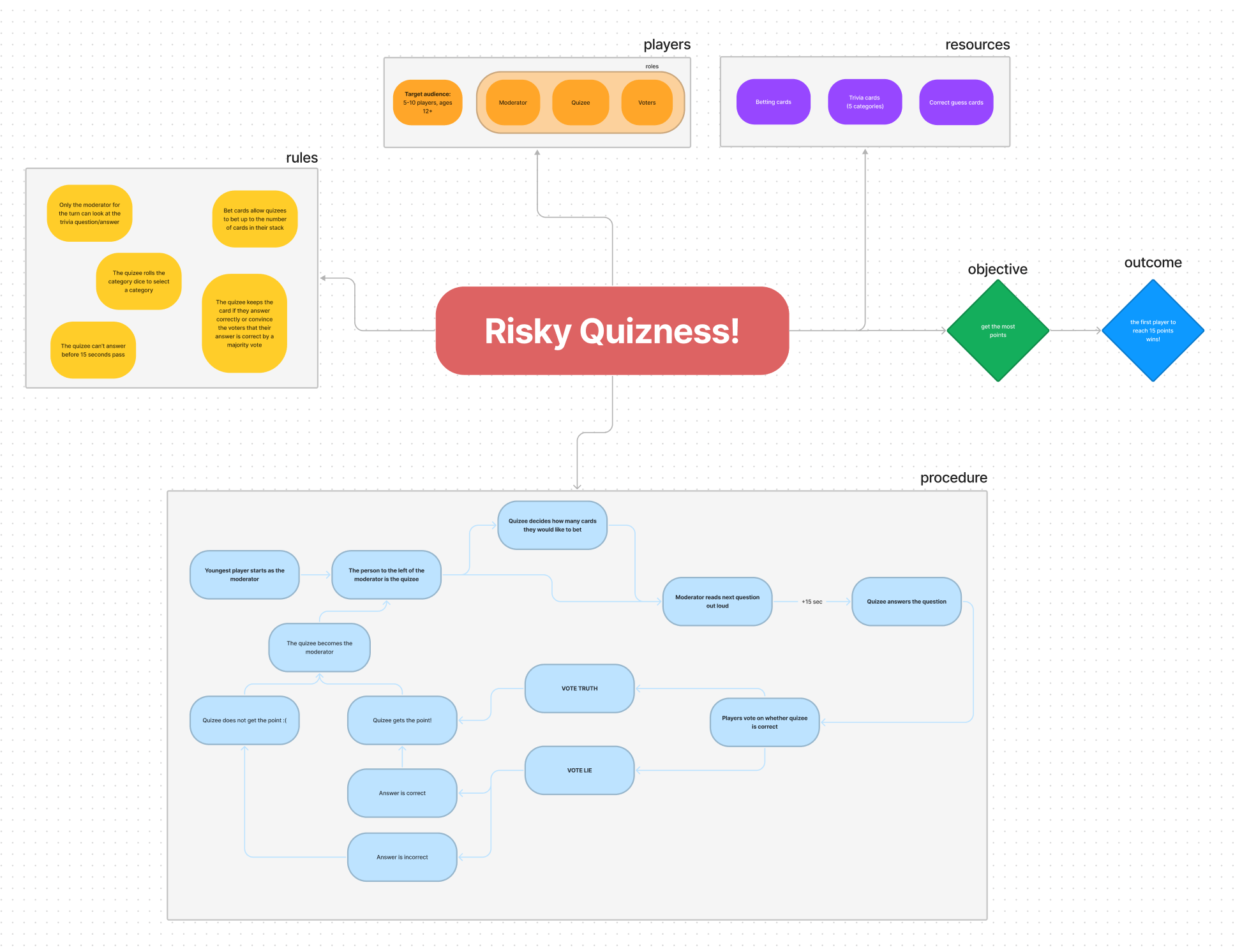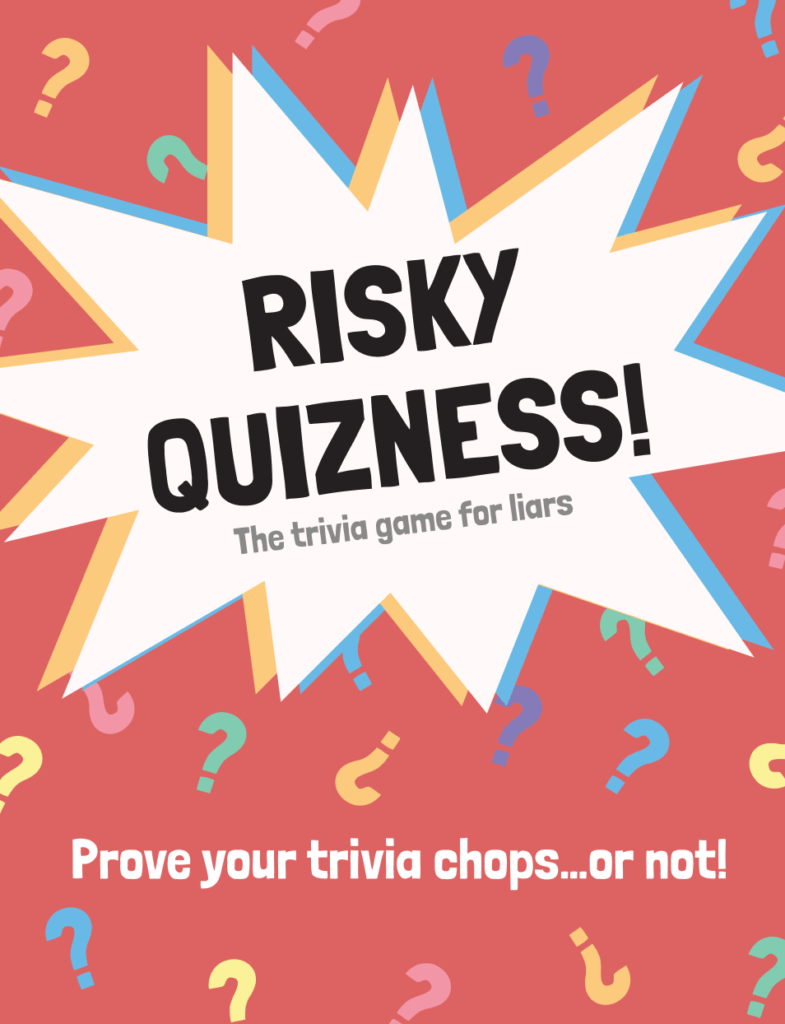by Alisa Wang, Carina Ly, Nadin Tamer
Artists’ Statement
Risky Quizness is a game that tests players’ trivia knowledge and fibbing skills. There are five different categories (Hodgepodge, Pop Culture, IMDb, School Stuff, and Stanny) with a wide variety of questions—quizees are given a question under one of these categories that are chosen at random by the roll of a dice. If the quizee is able to guess the right answer or is able to successfully convince other players that their made-up guess is correct, they get the point. However, if the other players can detect the made-up guess, then they are rewarded with a “Correct Guess” card. Risky Quizness also has a betting mechanic to make things more exciting, where players can risk their cards to earn more points.
Our game was inspired by our shared love for trivia games such as Jeopardy! and Trivia Crack. However, we felt that these games were always way more fun for people who actually knew the answers, and wanted to level the playing field by adding in a social deception twist!
We intended to incorporate Fellowship as our main type of fun – we wanted our game to facilitate meaningful social interactions between players, and hopefully elicit laughter about failed fibs and surprise about weird facts. Our game also incorporates discovery, since players are able to learn new facts and knowledge through the trivia questions.
Concept Map
Link to full FigJam concept map: https://www.figma.com/file/CIG7YesUhQ5wAGLt5jLOlj/Risky-Quizness-Concept-Map?node-id=0%3A1
Formal Elements
Players
Our game can be played with 5-10 players. Our target audience is college students, but the game is also accessible to anyone 12+ in age. There are several roles in the game, including one quizee who answers trivia questions and one moderator who asks trivia questions. The remaining players are voters, who vote on whether they think the quizee answered a trivia question correctly. Quizee and moderator roles rotate each round.
Objectives
The objective of our game is to score the most points. Points can be scored when a quizee answers a question correctly or if they convince a majority of voters that they have answered correctly. Voters can also earn a point if they correctly guess whether the quizee answered a trivia question with the right answer or not.
Outcomes
The outcome of the game is to determine the winner. The first player to earn 15 points wins.
Procedure
Before the game starts, each player is dealt voter cards (1 truth card and 1 lie card). The game begins after a moderator and a quizee (the person to the left of the moderator) are selected. If the moderator draws a bet card, the quizee can decide how many cards they would like to bet. The moderator then reads the question and point value from the selected category card out loud. The quizee has around 15 seconds to answer the question. After hearing the answer, players vote on whether the quizee is correct or not using their voter cards. The quizee can defend their answer if they wish, but the moderator must stay silent. Voters can not discuss amongst each other but they can ask the quizee any clarifying questions. If the quizee is correct or if they convince the voters by majority vote that they are correct, they get the point. Each voter gains a correct guess card if they correctly determine whether the quizee’s answer is correct or not. Then, the quizee becomes the moderator for the next round, and the process repeats. The first player to reach 15 points wins.
Boundaries
The rules of the game define the boundaries of the “magic circle”. Players are able to assume roles as they answer trivia questions and normal social rules about fibbing do not apply when playing this game.
Conflict
There is conflict in the game since players are competing with each other in this player vs. player game with the objective of each individual scoring the most points to win. The trivia questions themselves present another challenge with test knowledge. Player’s abilities to fib and to understand other players are also tested.
Resources
The main resources used in the game are the betting cards and the trivia cards. Voter cards and a timer are also used to facilitate gameplay.
Values
This game is intended to build community and test trivia knowledge in an engaging way. We valued promoting fellowship as our main type of fun since we wanted players to engage with each other and learn more about how others act under pressure. We also hoped to promote discovery as a type of fun with players being able to gain more knowledge from our trivia questions.

Testing & Iteration History
Throughout the past few weeks, we conducted three different playtests and adjusted the game between each playtest based on the feedback we got:
Playtest 1 (during class 3A)
Our initial game had a lot of mechanics. We had wanted there to be a time limit: the quizee was given a quiz category by using a virtual spinner. Then, they were given 10 seconds to write down their answers on a whiteboard and 20 seconds for the other players to deliberate. We found:
What went well
- People liked that there were different categories of questions, and they thought that the color coding was useful.
- People liked the idea of trivia, as it is a popular type of game to play at parties.
- The roles of the quizee and moderator were clear to the players.
What didn’t go well
- The questions are hard
- The target audience was not reached, they wanted more relevant questions
- Quizee asked the moderator for clarification on questions because the questions may be hard
- It was cumbersome to move between spinner, timer, and another deliberation timer
- Maybe cut down with the timer, for example, 30 seconds for everything.
- The rules were too long that players did not really bother reading
- Missing the point about the fibbing part (e.g. confused expressions when answering the questions)
- Skipped when they didn’t know the answer and moved to the next person
- The voting process was fast and mostly unanimous
- People seemed to vote that they thought answers were correct even when they didn’t think so
- Players put the used cards back into the pile
- People weren’t sure what the correct guess cards were for
- People drew the answers on the whiteboard instead of writing them out
What we decided to change
- Get rid of some mechanics, specifically the timer
- Shortened the instructions because people did not want to read too long of directions
- We wanted to draw more attention to our pop culture questions, as during this iteration, by chance, players could only answer science and history questions, arguably the hardest categories
Playtest 2 (during class 3B)
For our second playtest, we decided to simplify our game by getting rid of some of the complicated mechanics to see if people would get more into the social deception aspect. Specifically, we decided to get test playing without a time limit (hourglass).
What went well
- The pop culture questions went over really well and people got into engaged discussions trying to figure out the answer (e.g. + “What if it was Brad Pitt and Jennifer Aniston?” – “OK, but I feel it wouldn’t say Bennifer unless the guy’s name was Ben”)
- Overall, people seemed to like the trivia aspect of the game – one player started doing a game announcer voice while reading out the questions as moderator, showing that they got into the role.
What didn’t go well
- People still didn’t seem to get into the social deception aspect of the game, and didn’t really attempt to bluff if they didn’t know the answer, so people usually unanimously voted that they were wrong. One person said “I can’t just think of random things!”.
- Players seemed to agree that especially the more academic categories like Arts & Literature or History were too difficult for them to convincingly bluff on, especially since there was a limited problem space for them to come up with guesses within (e.g. the names of operas or Japanese emperors).
- People didn’t really use the whiteboards, but rather just blurted out the answer.
- People thought that the spinner animation took too long
What we decided to change
- We decided to completely overhaul our categories to make them more suited to our target audience of college students, especially since we got feedback that the questions were too difficult. Our old categories were Potpourri, Arts & Literature, History, Science, and Pop Culture. We decided to change them to Potpourri (Miscellaneous), Pop Culture, IMDb (Movies/Entertainment), Stanny (Stanford), and School Stuff (History/Science/Arts combined).
- We also decided to do away with the whiteboards and simply have people say their answers verbally, since people didn’t seem to find them useful and only one person answers questions at a time.
- People said that not having a time limit felt like the game dragged on, and recommended setting a limit of 15 seconds.
Playtest 3 (during class 4A)
For our final playtest, we wanted to test our new categories to see if people would enjoy them more, as well as test having people answer verbally. We also wanted to test whether people found having the correct guess cards useful/rewarding or cumbersome.
What went well
- People said they enjoyed the physical aspect of getting to keep the correct guess cards, like a token of their success.
- People liked being able to choose their own categories if they rolled a 6.
- There was a lot of discussion between players for each question (e.g. trying to count up all the fountains on Stanford campus together).
What didn’t go well
- People were confused about the meaning of Potpourri as a category (they thought it was related to plants).
- People were reluctant to discuss with the rest of the group before voting because it was to their disadvantage to tell others whether the quizee was correct or not. They suggested having people vote individually (without discussing with the group) to make it more competitive, and give the quizee a better chance at bluffing.
- Overall, players wished the game had moved faster and recommended making the time limit for answering shorter.
What we decided to change
- Rename Potpourri to Hodgepodge to make it clearer that it’s a category of miscellaneous questions, and rename IYKYK to Pop Culture for clarity since people expressed confusion.
- Introduce Truth/Lie voting cards to eliminate groupthink or being influenced by other players during the voting process, and ban group discussion (forcing people to vote individually)
- Remove the category die to make the game mechanics simpler and just have one big stack of cards instead of separate category piles.
- Change the objective of the game – the first player to 10 points wins. This will help the game rounds finish faster, rather than having to wait to play through all of the cards.
Playtest 3 Video Link: https://www.youtube.com/watch?v=ZGE7Q-XBcck
Final Prototype (Print & Play) Figma Link: https://www.figma.com/file/lBvvsUyVkkqquoTYS1yPDo/Risky-Quizness?node-id=0%3A1




